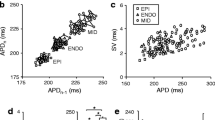Abstract
Drug-induced action potential duration (APD) prolongation was first proposed to be antiarrhythmic, but is now widely presumed to be torsadogenic. To elucidate this paradox, we tested the effect of APD upon liability for torsade de pointes. In addition, torsadogenicity is commonly associated with disturbances of repolarization, but at least in theory, it could also result from disturbances of conduction. These possibilities were tested in female rabbit hearts. Dofetilide, ATX II, and sodium channel blockers that did not prolong the action potential duration were used to modulate the APD and induce disturbances of conduction and disturbances of repolarization. Torsadogenicity could be induced by dofetilide and ATX II starting at normal APD (210 ms), reaching a peak incidence around a doubling of APD (400 to 450 ms), to then sharply decline with further APD prolongation, until torsade de pointes disappeared above 725 ms. Early afterdepolarizations (EAD) were regular triggers for torsade de pointes; while most of the EADs occurred in the plateau range, their incidence declined with repolarization but their potential for torsadogenicity increased. Sodium channel blockers that shorten the APD, even when devoid of hERG blocking properties, can yield torsade de pointes. Torsade de pointes can occur at normal, prolonged, and shortened APD, so that QT prolongation is an incomplete predictor of torsadogenicity. Torsade de pointes can result not only from disturbances of repolarization but also from disturbances of conduction.






Similar content being viewed by others
Abbreviations
- APD:
-
Action potential duration
- λ :
-
CV × ERP
- CV:
-
Conduction velocity
- ERP:
-
Effective refractory period
- TdP:
-
Torsade de pointes
- VT:
-
Ventricular tachycardia
- VF:
-
Ventricular fibrillation
- TRIaD:
-
Triangulation Reverse use dependence, Instability and Dispersion
References
Dessertenne F (1966) La tachycardia ventriculaire à deux foyers opposés variables. Arch Mal Coeur 59:263–272
Ficker E, Jarolimek W, Kiehn J, Baumann A, Brown AM (1998) Molecular determinants of dofetilide block of HERG K+ channels. Circ Res 82:386–395
Hondeghem LM (1994) Computer aided development of antiarrhythmic agents with class IIIa properties. J Cardiovasc Electrophysiol 5:711–721
Hondeghem LM (2006) Thorough QT/QTc not so thorough: removes torsadogenic predictors from the T-wave, incriminates safe drugs, and misses profibrillatory drugs. J Cardiovasc Electrophysiol 17:337–340
Hondeghem LM (2008) QT prolongation is an unreliable predictor of ventricular arrhythmia. Heart Rhythm 5:1210–1212
Hondeghem LM, Katzung BG (1977) Time- and voltage-dependent interactions of antiarrhythmic drugs with cardiac sodium channels. Biochim Biophys Acta 472:373–398
Hondeghem LM, Snyders DJ (1990) Class III antiarrhythmic agents have a lot of potential but a long way to go: Reduced effectiveness and dangers of reverse use-dependence. Circulation 81:686–690
Hondeghem L, Carlsson L, Duker G (2001) Instability and triangulation of the action potential predict serious proarrhythmia, but APD prolongation is antiarrhythmic. Circulation 103:2004–2013
Hondeghem LM, Lu HR, van RossemK D, Clerck F (2003) Detection of proarrhythmia in the female rabbit heart: blinded validation. J Cardiovasc Electrophysiol 14:287–294
Isenberg G, Ravens U (1984) The effects of the Anemonia sulcata toxin (ATX II) on membrane currents of isolated mammalian myocytes. The effects of the Anemonia sulcata toxin (ATX II) on membrane currents of isolated mammalian myocytes. J Physiol 357:127–149
January CT, Chau V, Makielski JC (1991) Triggered activity in the heart: cellular mechanisms of early after-depolarizations. Eur Heart J 12(Suppl F):4–9
Kannankeril PJ, Roden DM (2007) Drug-induced long QT and torsade de pointes: recent advances. Curr Opin Cardiol 22:39–43
Lewis T, Drury AN (1926) Revised views of refractory period in relation to drugs reputed to pro-long it and in relation to circus movement. Heart 13:95–100
Lipicky RJ (1993) A viewpoint on drugs that prolong the QTc interval. Am J Cardiol 72:53B–54B
Lu HR, Remeysen P, Somers K, Saels A, De Clerck F (2001) Female gender is a risk factor for drug-induced long QT and cardiac arrhythmias in an in vivo rabbit model. J Cardiovasc Electrophysiol 12:538–545
Milberg P, Eckardt L, Bruns HJ, Biertz J, Ramtin S, Reinsch N, Fleischer D, Kirchhof P, Fabritz L, Breithardt G, Haverkamp W (2002) Divergent proarrhythmic potential of macrolide antibiotics despite similar QT prolongation: fast phase 3 repolarization prevents early afterdepolarizations and torsade de pointes. J Pharmacol Exp Ther 303:218–225
Morganroth J (1987) Comparative efficacy and safety of oral mexiletine and quinidine in benign or potentially lethal ventricular arrhythmias. Am J Cardiol 60:1276–1281
Nattel S (1999) The molecular and ionic specificity of antiarrhythmic drug actions. J Cardiovasc Electrophysiol 10:272–282
Qian YW, Qian YW, Sung RJ, Lin SF, Province R, Clusin WT (2003) Spatial heterogeneity of action potential alternans during global ischemia in the rabbit heart. Am J Physiol Heart Circ Physiol 285:H2722–H2733
Roden DM (1993) Current status of class III antiarrhythmic drug therapy. Am J Cardiol 72:50B–52B
Roden DM (2005) Drug-induced prolongation of QT interval. N Engl J Med 350:1013–1022
Shah RR, Hondeghem LM (2005) Refining detection of drug-induced proarrhythmia: QT interval and TRIaD. Heart Rhythm 2:758–772
Vaughan Williams EM (1989) Classification of antiarrhythmic agents. In: Vaughan Williams EM (ed) Antiarrhythmic drugs. Handbook of experimental pharmacology series (No 89), chapter 2. Springer, Berlin, pp 45–67
Viitasalo M, Paavonen KJ, Swan H, Kontula K, Toivonen L (2005) Effects of epinephrine on right ventricular monophasic action potentials in the LQT1 versus LQT2 form of long QT syndrome: preferential enhancement of “triangulation” in LQT1. Pacing Clin Electrophysiol 28:219–227
Acknowledgments
The author wishes to thank Elisabeth Beck, Jessica Bigneron, and Bruno Hespel for their assistance with the experiments. Many thanks to Dr. Belardinelli of CV Therapeutics for the donation of the dofetilide. This work was supported by grants from HPC and Novartis, and the authors declare to have no conflict of interest.
Author information
Authors and Affiliations
Corresponding author
Rights and permissions
About this article
Cite this article
Hondeghem, L.M., Dumotier, B. & Traebert, M. Oscillations of cardiac wave length and proarrhythmia. Naunyn-Schmied Arch Pharmacol 382, 367–376 (2010). https://doi.org/10.1007/s00210-010-0549-y
Received:
Accepted:
Published:
Issue Date:
DOI: https://doi.org/10.1007/s00210-010-0549-y




